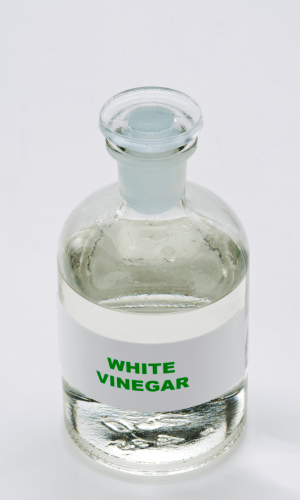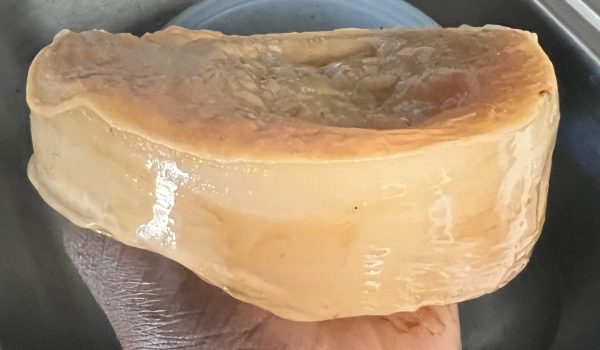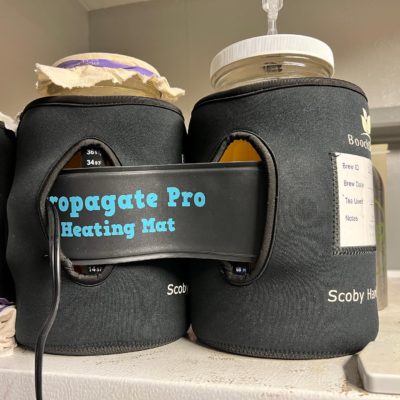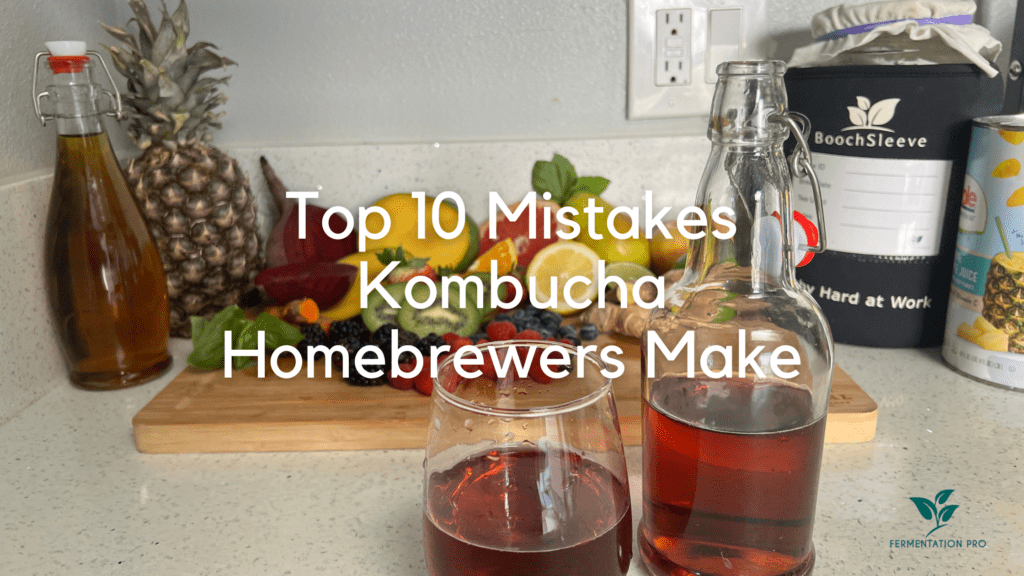Table of Contents
Adding Vinegar To Your Brew

We often get this question — should you add vinegar to the brewing process?
NO, vinegar should never be added to Kombucha as a starter liquid. Instead, use only well-fermented Kombucha as a starter liquid for your brews. Some recommend adding vinegar to the brew to act as a starter liquid or to help prevent mold. But don’t do it, and here’s why?
Kombucha is an acetic acid ferment, which means it belongs to the vinegar family. The bacteria in both are generally related but different in type and mix because the yeast is very different for each.
Vinegar is technically defined as having 4-8% acetic acid content. By contrast, Kombucha contains just 0.5-1.2% acetic acid. As a result, we do not need to dilute Kombucha to enjoy it as a beverage, making it an “easy-drinking” tea vinegar. In addition, the acetic acid in kombucha provides a delicious flavor punch and a host of other benefits.
Another reason for not adding vinegar to the brew is that it may introduce vinegar eels into your brew. These tiny worm/nematodes live in an acetic acid environment and feed off the mother Kombucha or the SCOBY. Though these eels are harmless to humans, they can weaken the SCOBY’s ability to brew Kombucha — As they feed off of the microbes which make up the culture and cause fermentation, with time, they will impact the health of your SCOBY severely.
If you notice the following problems with your SCOBY culture and fermentations, it is good to check for vinegar eels.
- Your kombucha is not maturing as quickly as it usually does.
- The culture lacks structure and is starting to deteriorate.
- The flavor profile has changed unexpectedly, and that change is not linked to a change in ingredients or conditions.
Here is how you can spot them vinegar eels:
Take your brew into a dark room or cupboard with a flashlight. If your brewing vessel is glass, simply shine the flashlight’s beam through the side. If the brewing vessel is ceramic, shine the light into the top. If vinegar eels are present in your brew, then you should be able to see them wriggling towards the light.
So if you suspect you have vinegar eel — there is only one thing left to do. It’s tough to get rid of vinegar eels — you just have to start over from scratch.
Using Weak Starter Tea
Okay, we all know the importance of having a healthy SCOBY, but have you ever wondered about your starter tea? Whether your starter tea is weak or just perfect for brewing Kombucha?
It is necessary to use mature starter tea, i.e., at least 7+ days older, bright, and have a strong acidic smell. Matured starter tea has developed all the vital acids and healthy bacteria needed to brew your next batch. So if you think about it, using a starter tea that is less than seven days old damages the quality of your Kombucha brew from the onset. So think twice about the age of the starter tea.
The starter tea and your SCOBY are the only ways to inoculate the batch. So if you are brewing your Kombucha with a weak starter tea, your Kombucha may grow mold and go bad.
Over-steeping Your Tea

Over steeping tea doesn’t have any harmful effects on the human body; it just makes the taste of Kombucha a bit strong and sometimes bitter. Some people steep their tea for 15 – 30 minutes, and some people do it just for 1 to 2 minutes and still find no significant difference in the quality. It’s just a matter of individual preference.
Based on our experience, we recommend steeping for 5-8 mins.
Keep in mind different teas have different flavors. For instance, white and green tea has a very subtle flavor. In this case, using these tea leaves as the base can have a more subtle tasting kombucha. Again, totally up to you. We used to brew with 4 black tea bags and one green for a one-gallon brew. Now we use a combination of black, green, and oolong loose tea.
Not Stirring Your Kombucha Tea
The yeast is responsible for the fizziness/carbonation of kombucha. The yeast settles down the brewing vessel at the end of the first fermentation process. So, when you bottle the Kombucha after your first fermentation without stirring it, some bottles may have too much yeast — those are the bottles that are filled from the bottom of the vessel, and others may not have enough. And so you will lack some fizziness because of that.
You should stir the Kombucha before bottling to distribute the yeast and make the Kombucha more consistent.
Adding Flavors To Your First Ferment (F1)
Adding flavors to the Kombucha generally occurs in the first of two steps. The first step is the fermentation process of the sweet tea with SCOBY, sugar, water, and starter tea that lasts longer (F1). The second step is the shorter fermenting period (F2), where the SCOBY and a bit of matured Kombucha are removed for the next batch, and the flavorings are added to the brew.
It is crucial to add flavors in two steps because the herbs, fruits, and other flavorings might cause the growth of mold spores on the SCOBY and damage the starter tea.
Using A Noncaloric Sweetener
So what are non-caloric sweeteners? Stevia or monk fruit are considered non-caloric sweeteners. Stevia is a sweetener and sugar substitute derived from the leaves of the plant species Stevia & Monk fruit sweeteners are created by removing the seeds and skin of the fruit, crushing the fruit, and collecting the juice. The fruit extract, or juice, contains zero calories per serving. You don’t want to use these in your booch because—
Your kombucha yeast and bacteria depend on sugar to survive and thrive. So using alternate sugars or not enough sugar deprives your culture of its food source. As a result, you’re starving your SCOBY and weakening it.
SCOBY is a combination of microbes and yeasts. Not using cane sugar or brewing with alternative sweeteners deprives the microbes of the nutrients required to change the sweet tea to Kombucha. Thus, it gives you poor-quality kombucha.
Using Poor Quality SCOBY
Before selecting or choosing a SCOBY, it is essential to define what precisely a SCOBY is. SCOBY is an acronym for “symbiotic culture of bacteria and yeast.” Technically it is the gelatinous rubbery piece most people define as a SCOBY floating at the top of a fermenting jar of kombucha AND the bits and pieces of bacterial and yeast within the brewing kombucha. We will refer to the SCOBY as just the flubber-like part typically floating on top of the brew for this article.
It is important to understand that a successful brew requires a good quality SCOBY and good quality starter tea. There are many reputable companies where you can purchase SCOBYs. Here is what you want to avoid.
Refrigerated SCOBY
SCOBYs are living organisms that thrive at room temperate. The bacteria and yeast become dormant below 55℉ or 13℃. Depending on how long they have been kept dormant, the entire colony may not survive the inactive state. This will affect the health of your fermenting kombucha. While the healthy bacteria are dormant, other harmful bacteria, such as mold, have a chance to take up residency on your SCOBY. Bottom line: don’t buy refrigerated SCOBYs and don’t refrigerate your SCOBYs.
Moldy SCOBY
Plain and simple, If a SCOBY has mold, it needs to be discarded. It is too risky to try and salvage a SCOBY that has mold. Do not try and remove the moldy part in an attempt to save the SCOBY. You don’t know if you can remove all the mold spores in attempting to cut out the moldy piece. It is best and safest to discard any SCOBY that has verified mold. And remember, there are lots of perfectly normal fermenting SCOBYs that might look like they have mold but do not, so it is vital to verify that it is moldy before discarding it.
Dehydrated SCOBY
This is a rare one, but some companies may still sell dehydrated SCOBY. Please avoid these at all costs! Like a SCOBY that has been refrigerated, these run the risk of developing mold if rehydrated because it has been deprived of the precious starter tea. A live and active culture continuously creates the acids that mold cannot thrive in. A dehydrated SCOBY has been removed from that environment and runs the risk of never recovering.
Small SCOBY/Too Little Starter Tea
This is particularly important when you are first starting to brew. You want to make sure that the SCOBY size and amount of starter tea are in proportion to the size of the brewing vessel. When you first start to brew, the initial batch has to be at a certain pH to fight off bad/harmful bacteria such as mold. The size of the SCOBY and the amount of starter tea determine the acidic strength of the initial batch. You want to make sure the pH is at 4.0 or lower when starting a batch.

Storing Your SCOBY In The Fridge
Your SCOBY is a living organism. It thrives in a specific environment and under certain conditions. Many people believe they can store their SCOBY in the fridge just like any other food product, but SCOBY doesn’t react the same way.
What’s Wrong With The Fridge?
Whether stored by itself or in starter tea, the SCOBY is not actively producing those healthy acids that help innoculate kombucha. This makes the SCOBY vulnerable to developing mold. In addition, the SCOBY may have a hard time coming out of the dormant state when it is removed from the fridge.
Where To Store It Instead:
Store your extra SCOBYs in a SCOBY hotel. A SCOBY hotel is simply a different brewing vessel just used to store extra SCOBYs. You can start a SCOBY hotel by brewing a concentrated sweet tea mixture, allowing it to cool to room temperature, and then adding a SCOBY to it. Over time the SCOBY will multiply and grow. You must periodically “feed” your SCOBY by adding more concentrated sweet tea.
Rinsing Your SCOBY
It is important to remember that the SCOBY is more than just the pellicle. It is more than just the big rubbery disc that you see typically floating on top of a brew. The SCOBY is comprised of all of the yeast and good bacteria. These are attached to the pellicle are throughout the brewing vessel. Knowing this will help you understand why it is not advisable to rinse your SCOBY pellicle.
If you rinse your SCOBY, you are removing a lot of the good bacteria and yeast attached to it. You want as many bacteria and yeast as possible to ensure a healthy brew. However, removing these makes your brew more susceptible to mold.
The only time when rinsing your SCOBY is acceptable is if you drop it while removing it from a brewing vessel or SCOBY hotel. If that is the case, you want to ensure that you rinse the SCOBY so that it doesn’t pick up any harmful bacteria or debris. You don’t want any of that introduced into your brew.
Brewing Kombucha In Direct Sunlight
Many people advise against brewing your kombucha indirect sunlight. So let’s address why that is the case. But, first, what is it about sunlight that can be harmful to brewing kombucha?.
Temperature Fluctuations
The heat from sunlight can dramatically increase the temperature of the Brew causing wide fluctuations between daytime brewing and nighttime Brewing. You could argue that the heat from sunlight would be beneficial for Brewing kombucha during winter. The ideal brewing temperature is 75 to 80℉ (24- 27℃), so whatever you can do to maintain that temperature range will produce a higher-quality brew. So in the wintertime or a colder climate, the heat from the sun might benefit brewing kombucha. So that’s when we get to temperature fluctuation: fluctuating temperatures that can be caused by sunlight is what is detrimental to brewing kombucha. Ideally, you want to maintain a constant brewing temperature or keep it within a narrow temperature range. However, with the natural pattern of night and day, the sun will heat the kombucha rapidly, and at night it will cool off to a much lower temperature. This causes a significant temperature fluctuation which is detrimental to brewing kombucha.
UV Light
The ultraviolet light from sunlight can be harmful to brewing kombucha because it acts as an antibacterial, which can kill off good SCOBY bacteria. Ultraviolet light-emitting devices are routinely used in disinfecting machines and devices. You want to make sure that wherever you are brewing, your kombucha is not coming into contact with direct sunlight for this reason.
Visible Light
The yeast in the SCOBY is very sensitive to visible light. Most, if not all, yeast have a sensitivity to visible light. Keeping your brewing vessel out of direct sunlight can help the yeast properly grow and help maintain the proper balance of yeast and bacteria in your Brew. In beer production, beer is brewed in dark containers because light disrupts the yeast and negatively affects the beer’s flavor. The less visible light that reaches the brewing kombucha, the more consistent and predictable your brew will become.










39 Responses
ΕΥΧΑΡΙΣΤΩ ΠΟΛΥ
Good day very cool blog!! Man .. Excellent .. Superb .. I will bookmark your site and take the feeds alsoKI’m happy to seek out so many useful info right here in the put up, we’d like work out more techniques on this regard, thanks for sharing. . . . . .
Nice post. I study one thing more challenging on completely different blogs everyday. It is going to always be stimulating to read content from other writers and follow somewhat one thing from their store. I’d choose to make use of some with the content material on my blog whether you don’t mind. Natually I’ll offer you a link in your internet blog. Thanks for sharing.
Hello.This article was really fascinating, particularly since I was searching for thoughts on this subject last week.
As a Newbie, I am continuously exploring online for articles that can help me. Thank you
There are definitely lots of particulars like that to take into consideration. That could be a great point to bring up. I supply the ideas above as general inspiration but clearly there are questions like the one you deliver up where a very powerful thing can be working in trustworthy good faith. I don?t know if best practices have emerged around things like that, however I’m certain that your job is clearly recognized as a fair game. Each boys and girls feel the affect of only a second’s pleasure, for the rest of their lives.
I really appreciate this post. I have been looking everywhere for this! Thank goodness I found it on Bing. You have made my day! Thx again
Wow, incredible blog format! How lengthy have you been running a blog for? you made running a blog look easy. The full glance of your website is wonderful, let alone the content material!
I do not even understand how I ended up right here, however I assumed this post used to be great. I do not recognise who you might be however definitely you are going to a well-known blogger in the event you are not already 😉 Cheers!
I got good info from your blog
Wow, marvelous blog layout! How lengthy have you ever been blogging
for? you make running a blog look easy. The full look of your website is fantastic, as well
as the content! You can see similar here sklep online
It?¦s actually a great and helpful piece of information. I am satisfied that you simply shared this helpful information with us. Please keep us informed like this. Thanks for sharing.
Great post. I was checking constantly this blog and I’m impressed! Extremely useful info specially the last part 🙂 I care for such info much. I was seeking this certain info for a very long time. Thank you and best of luck.
Somebody necessarily assist to make severely articles I would state. That is the first time I frequented your web page and to this point? I amazed with the research you made to create this particular submit extraordinary. Fantastic job!
Great ?V I should definitely pronounce, impressed with your site. I had no trouble navigating through all the tabs as well as related info ended up being truly simple to do to access. I recently found what I hoped for before you know it in the least. Reasonably unusual. Is likely to appreciate it for those who add forums or something, website theme . a tones way for your customer to communicate. Excellent task..
Excellent site. A lot of useful info here. I am sending it to a few pals ans also sharing in delicious. And obviously, thank you in your effort!
The next time I read a blog, I hope that it doesnt disappoint me as much as this one. I mean, I know it was my choice to read, but I actually thought youd have something interesting to say. All I hear is a bunch of whining about something that you could fix if you werent too busy looking for attention.
Awsome info and right to the point. I am not sure if this is in fact the best place to ask but do you people have any thoughts on where to get some professional writers? Thank you 🙂
I haven¦t checked in here for a while since I thought it was getting boring, but the last several posts are great quality so I guess I¦ll add you back to my daily bloglist. You deserve it my friend 🙂
Very interesting points you have noted, regards for putting up.
Tonic Greens, a natural health supplement, is designed to enhance immune function.
What Is FitSpresso? The 100 natural formula is formulated using a potent blend of 6 ingredients
whoah this weblog is wonderful i really like studying your posts. Stay up the great paintings! You recognize, many persons are hunting round for this information, you could aid them greatly.
I have been absent for some time, but now I remember why I used to love this blog. Thank you, I?¦ll try and check back more frequently. How frequently you update your website?
This is a topic close to my heart cheers, where are your contact details though?
What i do not realize is actually how you’re not really much more smartly-appreciated than you may be now. You’re very intelligent. You already know thus considerably when it comes to this subject, produced me personally imagine it from numerous various angles. Its like men and women aren’t fascinated except it is one thing to do with Woman gaga! Your personal stuffs great. At all times maintain it up!